Not Too Wet To Burn
Amid an uptick in wildfires, scientists search for lessons on how to save old-growth rainforests from a fiery future.
Article body copy
A recipe for a forest starts with basic ingredients—soil, seeds, sun, and water. But just like the recipe for chowder or pancakes or any other well-loved dish, the composition and flavor varies from place to place.
The forests of the Pacific Northwest, for instance, are made with prodigious quantities of water. Some of the rainiest spots on the continent lie along a strip of land between the Pacific Ocean and the western slopes of the Cascade Range from northern California up to Oregon and Washington. The sodden conditions continue up the west side of the Coast Mountains in British Columbia and through the Alaska Panhandle to the edge of Prince William Sound, close to Anchorage, Alaska. All along this region grows a dense tangle of lush forest.
It is “a pretty good spot on the planet to grow big trees really fast,” explains University of Washington forest fire ecologist Brian Harvey on a vividly clear day in late July 2023. He and seven others—a mix of students and seasoned researchers—are standing in a patch of forest about 10 kilometers from the northeast entrance of Mount Rainier National Park in Washington State. The group traveled here by SUV from Seattle this morning. To reach this spot of trees, they also scrambled down a nearly 40-degree slope covered in twiggy undergrowth and soil so thick with layers of castoff tree needles that it was like walking on hay or feathers. The researchers hail from several locations—including Australia (with its famous eucalyptus forests) and inland California (with its drier landscapes of oaks and conifers). Some are less familiar with the northwest’s moist, mossy treescapes.
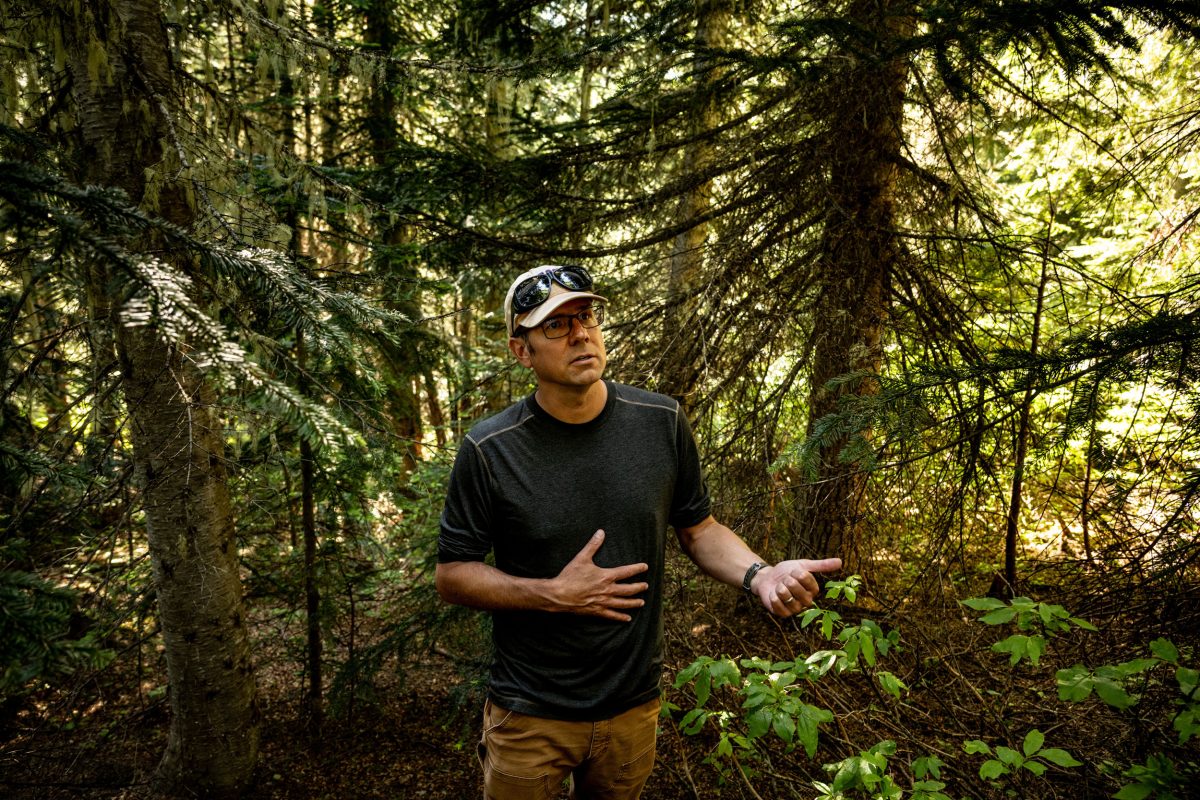
University of Washington forest fire ecologist Brian Harvey studies how rainforests are impacted by major wildfires, including the Norse Peak Fire that burned close to Washington State’s Mount Rainier National Park in 2017. Photo by Stuart Isett
The forest here receives about one and a half meters of precipitation every year, and some spots along the coast and western side of the mountains are drenched with two and a half to four meters annually (at the higher end, about enough water to submerge a one-story building if it all fell at once).
Moreover, this particular spot is an old-growth forest: it has never been commercially logged. Forests of the coastal Pacific Northwest, especially old-growth forests, are exceptionally productive and store an impressive amount of carbon—holding it in the trees and greenery and soil. A recent report by Parks Canada found that forested national parks in this region were the most carbon-rich in that country. In another study that mapped the world’s major natural carbon reserves, the temperate rainforest along the coast of British Columbia and the US Pacific Northwest ranked among the top six (along with the Amazon rainforest and tropical and subtropical mangrove swamps around the world). These damp North American forests hold about five gigatonnes of carbon—or what all of Canada emits from human causes every seven years or so. In a time of climate change, that makes these forests exceptionally important to the carbon budget of the planet.
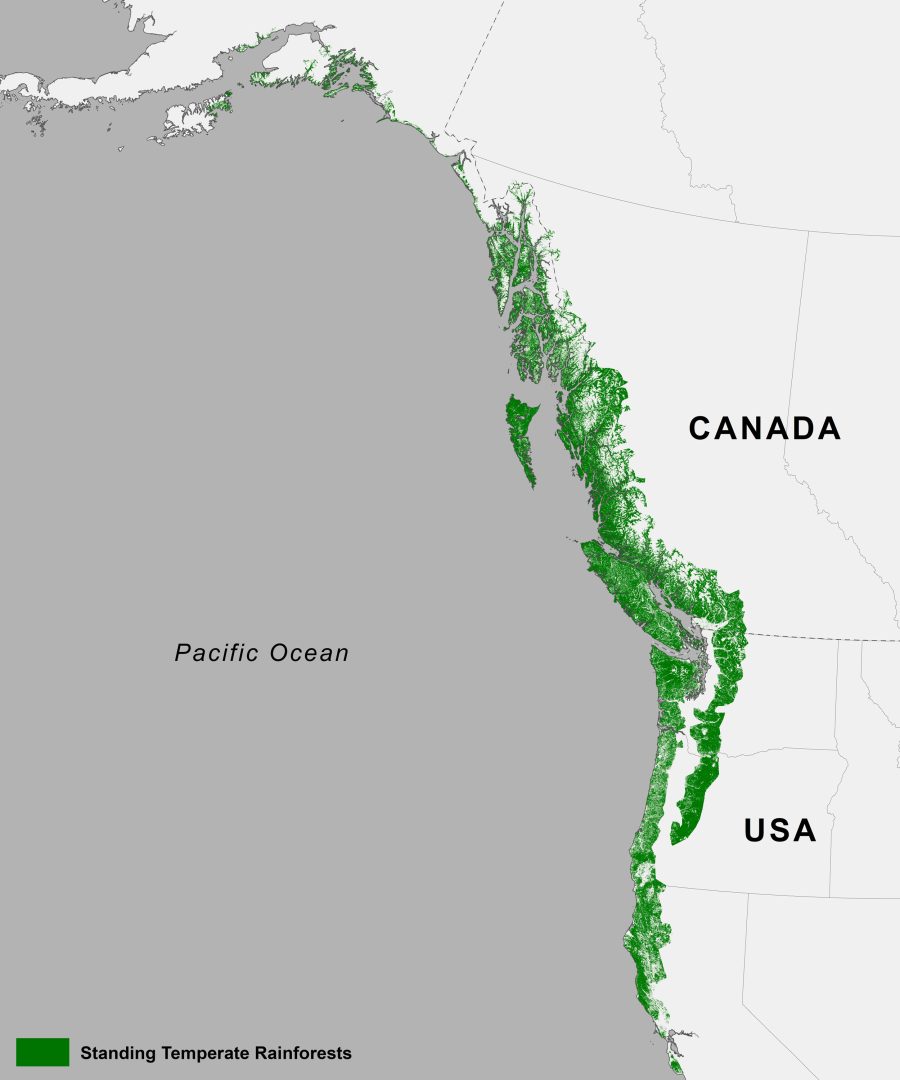
North America’s coastal temperate rainforest stretches from Northern California through British Columbia to Alaska. Map by Keith Holmes
So the scientists are here to consider an important question: what happens when you add heat to this particular forest recipe? To put it differently, what happens to the West Coast’s old-growth rainforests in an era of more wildfire?
Harvey appears almost to lean back against the vegetation behind him. He continues the forest-making lesson with the formality of a professor and the verve of a Scout troop leader: “So what do you notice?”
The researchers play along amiably, taking in the scene around them, gathering leaves and stems in their fingers, squinting at a little bird that vanishes before it can be identified. One of Harvey’s graduate students, Madison Laughlin, crouches in a cluster of green plants and begins reciting their names: bluebead lily, fireweed, pearly everlasting, ladyfern. Beneath the scientists’ shoes, the plants give off a zesty aroma, like fresh parsley. Above them, multiple generations of trees—noble fir, silver fir, Douglas fir, western hemlock—thrust their spiky crowns into the blue-eyed sky. Claire Willing, a fungal ecologist from the University of Washington, points to the mosses and lichens that hang from the tree bark. “Epiphytes,” Harvey nods in acknowledgment, “which is a fancy word for plants growing on other plants.” The hallmark of a wet old-growth forest is how layered and tangled it is. Motley sizes of giant trees, some centuries old, covered with mosses and lichens, cast shade over shrubs like vine maples and huckleberries. These stand beside dead stumps and rotting logs housing birds and squirrels, sprouting with more mosses and plants, and harboring spiders, salamanders, and cities of insects. Then at mouse-eye-level, on the forest floor, there are carpets of needles and leaves, mushrooms and rot, and colonies of wildflowers and seedlings. An ecologist would call this a community of species. A casual observer might see it as a beautiful green mess. But it’s also a tightly woven system of growth and decay and recycling, and water and carbon and nutrients.
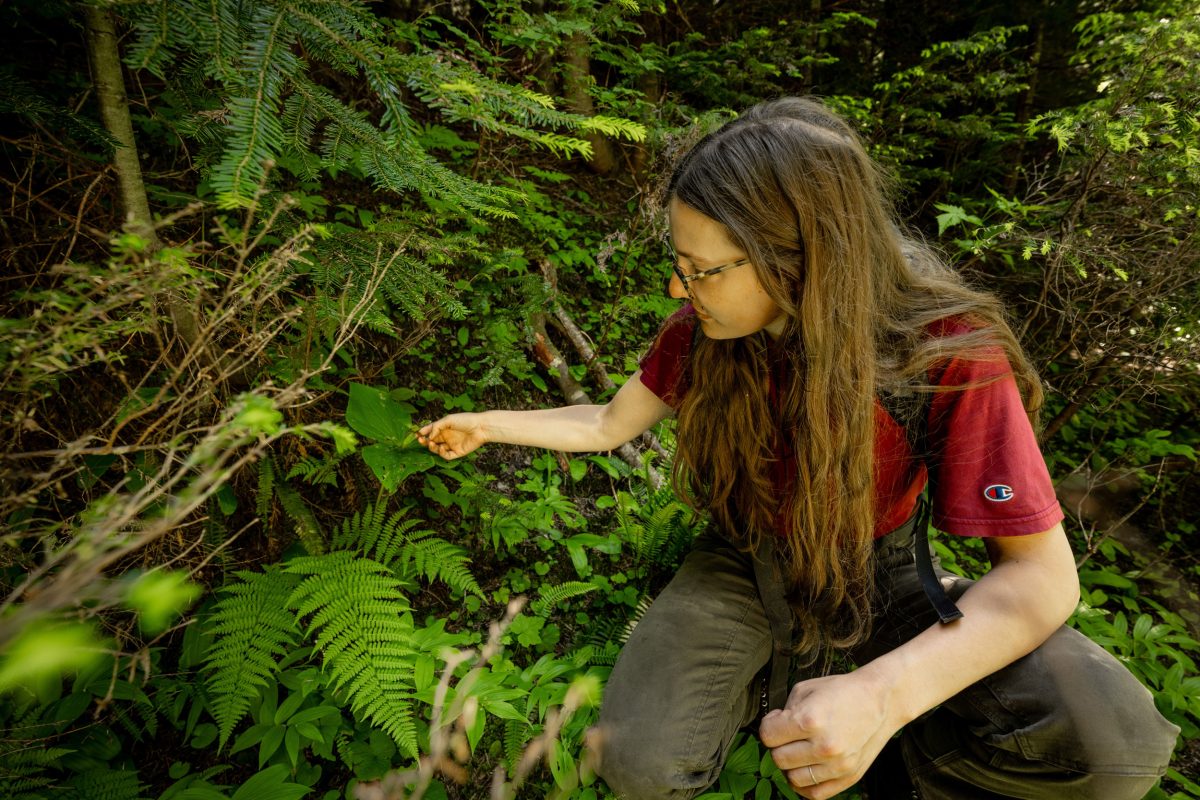
Madison Laughlin, a University of Washington graduate student in Brian Harvey’s lab, identifies the plants that sprout in an old-growth rainforest following a wildfire. Photo by Stuart Isett
There is a surprise ingredient in the creation of this old-growth forest, Harvey adds. He pats the flaking, moss-furred bark of a fallen silver fir behind him, causing a crowd of ants to scatter in alarm. “A silver fir tree can live to be several centuries old, so this thing has grown, died, and fallen since the last stand-replacing fire.” Stand-replacing. This cluster of forest—and most of the stands of trees around it—was born after a wildfire about three centuries ago that almost completely killed off or replaced the previous set of trees. While some kinds of forests are adapted to frequent fires—full of species that can survive or resprout after a moderate blaze (like a garden after an enthusiastic pruning)—a damp forest like this historically only saw fire every few centuries. When one does ignite, many of the trees here simply die, and the process of forest-growing restarts from the beginning—like sowing a bed of seeds nearly from scratch.
For the past few years, Harvey has been researching in great detail how a forest as old and wet as this one regenerates after a wildfire. This used to be a harder question to study in this region. Wildfires are more common to drier forests (and to some wet forests farther south, like California’s coastal redwoods), where they historically burned from every few years to every few decades. Forest fires are also becoming more frequent and extreme across much of North America as climate change creates hotter and more fire-prone conditions. But in most of the Pacific Northwest’s rainforest, fire has been a rare visitor—arriving every few to several centuries. Here in Washington State, it used to be tough to find a rainforest that had burned recently enough to study its recovery in real time—until the last few years.
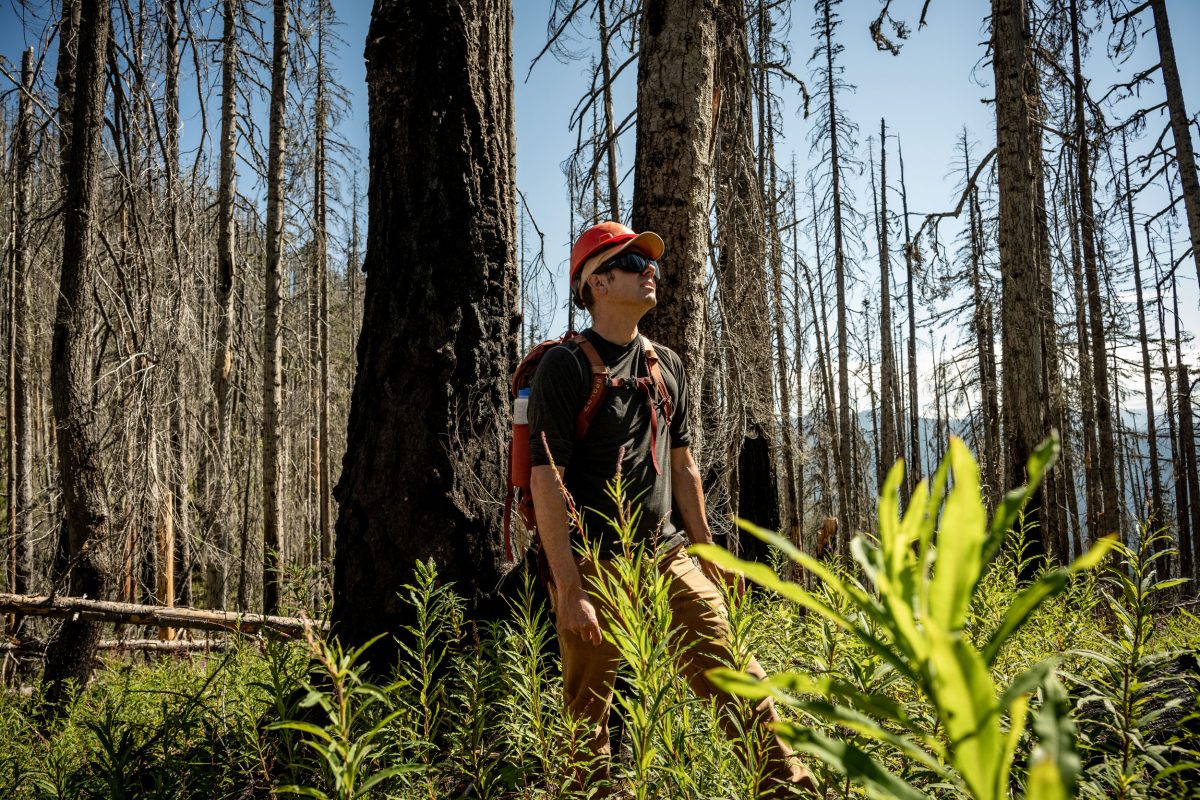
Harvey leads researchers and students into a section of old-growth forest damaged in the 2017 Norse Peak Fire. Photo by Stuart Isett
In 2017, just a few kilometers from where Harvey and his colleagues are standing, a wildfire, propelled by hot, dry easterly winds, charged through more than 20,000 hectares of forest. After the flames died down, Harvey partnered with a group of state and federal agencies, along with the Tulalip Tribe in western Washington, to study recent wildfires in wet coastal-side forests. Now he and his crew are measuring the impact of forest fire in 165 research plots—stretching from northern Oregon to North Cascades National Park, about 50 kilometers from the Canadian border. Dozens of these plots lie in the burn scar left by what came to be known as the Norse Peak Fire.
Even more disturbing fire conditions arrived in the region three years later. “The 2020 fires were a bit of wake-up call,” says Jessica Halofsky with the US Forest Service. During early September that year, a vicious combination of aggressive easterly winds, drought, and hot weather powered colossal wildfires across the entire US Pacific Northwest, lighting up more than 300,000 hectares in Washington State and more than 450,000 in Oregon. Megafires surged on both the dry inland and the damp coastal sides of the Cascade Range. Southeast of Portland, Oregon, for instance, the Beachie Creek and Lionshead Fires sprawled across the east and west slopes. They each burned about 80,000 hectares.
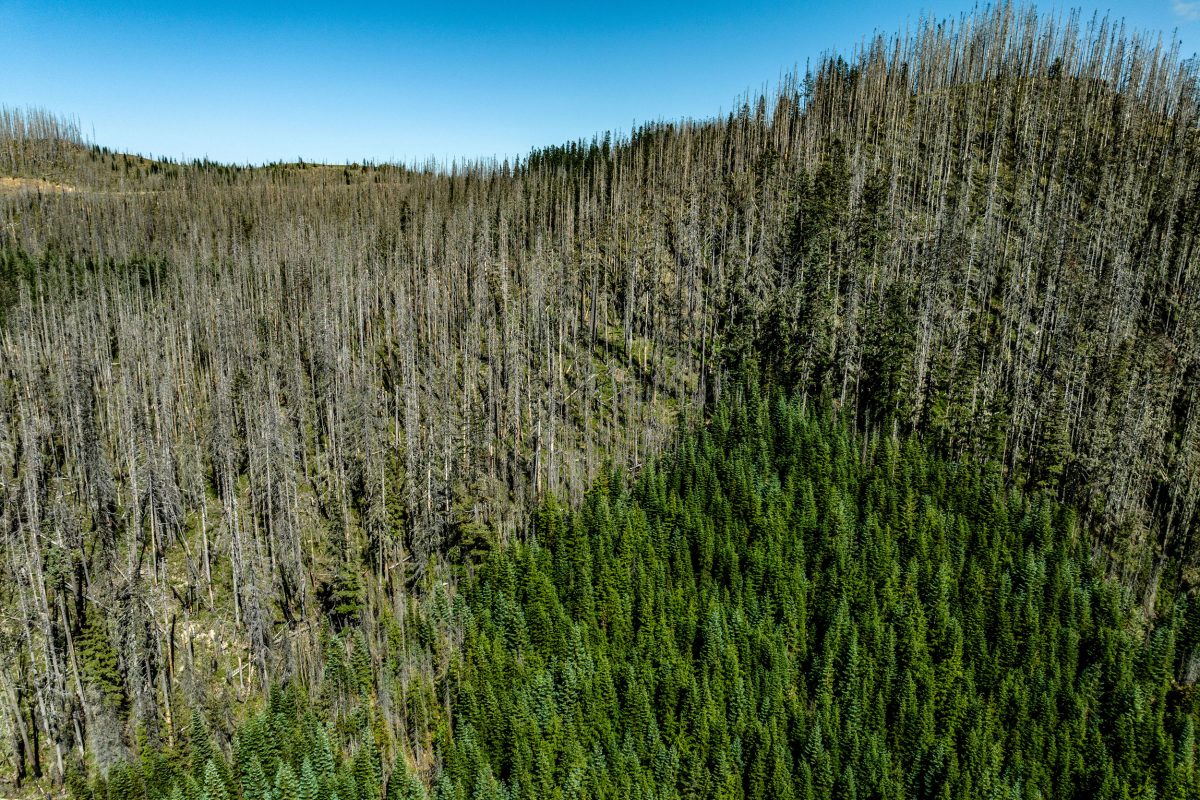
Lightning strikes caused the Norse Peak Fire in August 2017, which began on the east side of the Cascade Range but jumped to the west side, burning over 22,000 hectares by the time it was contained two months later. Photo by Stuart Isett
Western Canada may not yet have experienced significantly more wildfires in coastal rainforests (sometimes termed “hypermaritime forests,” as in extra-wet and coastal). In a study in the journal Nature, a team of scientists couldn’t find a rising trend of coastal burns in British Columbia between 1900 and 2021. But, they wrote, hotter weather and easterly “fire winds” could set the coast up for some alarming disasters. A major wildfire did burn through Tweedsmuir Park in 2018, hitting some coastal forest. The 2023 season was also the fieriest, by far, in a century for coastal British Columbia. (It was also the worst fire year on record across all of Canada.)
Now scientists want to know more about what happens when a rainforest catches fire. And can we help these forests endure?
In the history of the North American environmental movement, the old-growth rainforests of the Pacific Northwest are like celebrities. Arguably, all forests have a certain charisma, but these towering, drippy forests are special. They inspired the fictional tree-centric society of Ernest Callenbach’s 1975 novel Ecotopia and the real-life “timber wars” that began in the 1980s, when protestors—led by First Nations in Canada and primarily by environmental groups like Earth First! in the United States—blockaded logging trucks and occupied the crowns of trees to prevent their felling by commercial logging companies. In the United States, forest protests mostly ceased after the mid-1990s when the Clinton administration adopted a forest management plan that sharply curtailed old-growth logging. But such logging and tree activism continues on the Canadian side. In 2021, thousands of activists staged a forest blockade on Vancouver Island as part of the ongoing Fairy Creek protests in what was the largest act of civil disobedience in Canadian history in terms of arrests.
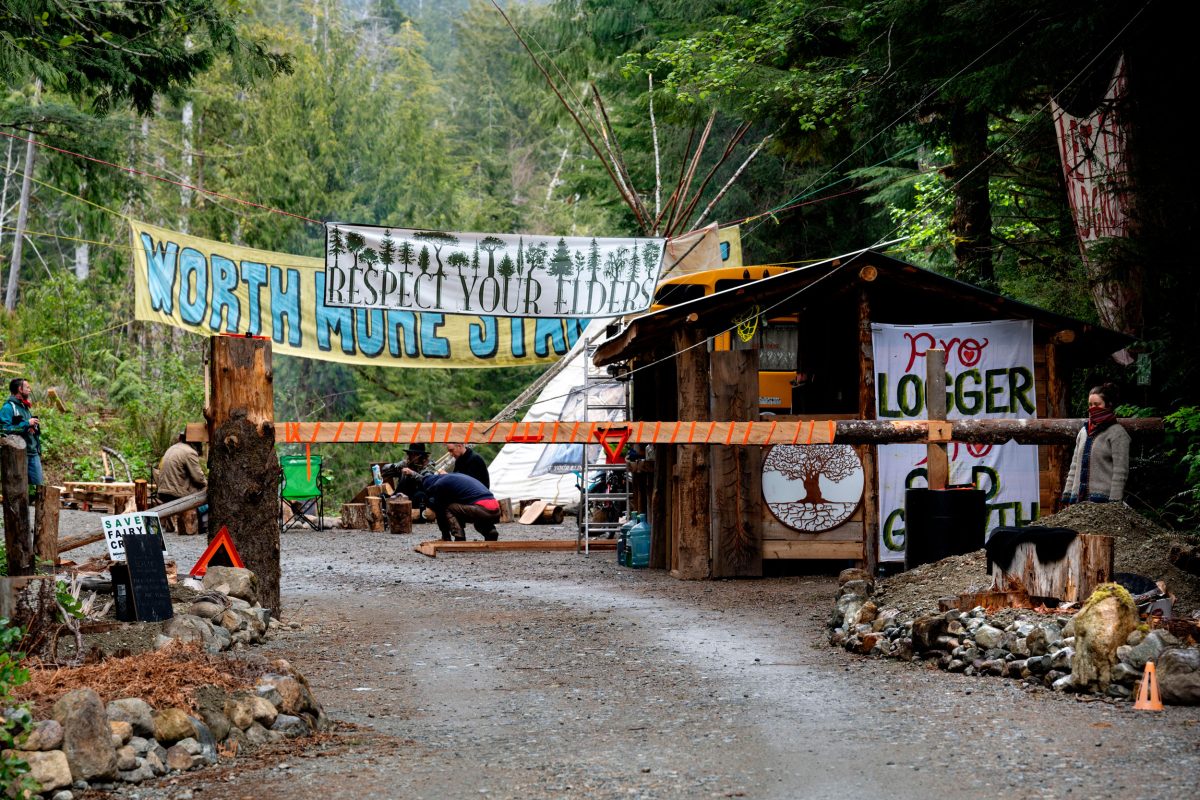
On Vancouver Island, British Columbia, thousands of activists staged a forest blockade in 2021 as part of the ongoing Fairy Creek protests to save what little is left of British Columbia’s old-growth forests. Photo by Wirestock Inc./Alamy Stock Photo
But what happens to these sylvan celebrities as the planet gets hotter?
In many parts of the world—from western North America to Australia, the Mediterranean, India, and Brazil—wildfire seasons are worsening as warmer temperatures dry out entire landscapes. The unprecedented Canadian wildfires of 2023 burned a whopping 18 million hectares of land and poured smoke into the skies across most of North America. In their wake, British Columbia–based journalist Barry Saxifrage published an analysis of satellite data and greenhouse gas inventories showing that Canadian “managed forests”—a category that includes both areas managed partly for timber harvest and more-protected national and provincial parks—have been releasing billions of tonnes of carbon into the atmosphere because of factors like fires, logging, and pests. Citing Saxifrage, New York Times columnist David Wallace-Wells wrote, “trees are not perfect allies for tree huggers anymore, and forests no longer reliable climate partners.”
Increasingly, forests seem troubled, vulnerable, perhaps even dangerous. But Ronnie Drever, senior conservation scientist with Nature United, calls Wallace-Wells’s perspective “overly simplistic.” Wildfire is still relatively rare in some kinds of North American forests—including the maritime forests of Nova Scotia and New Brunswick. A boreal forest in some parts of these regions may only burn, on average, once every few centuries. It is still possible to protect and restore forests, Drever insists—especially those that can persist in dampness.
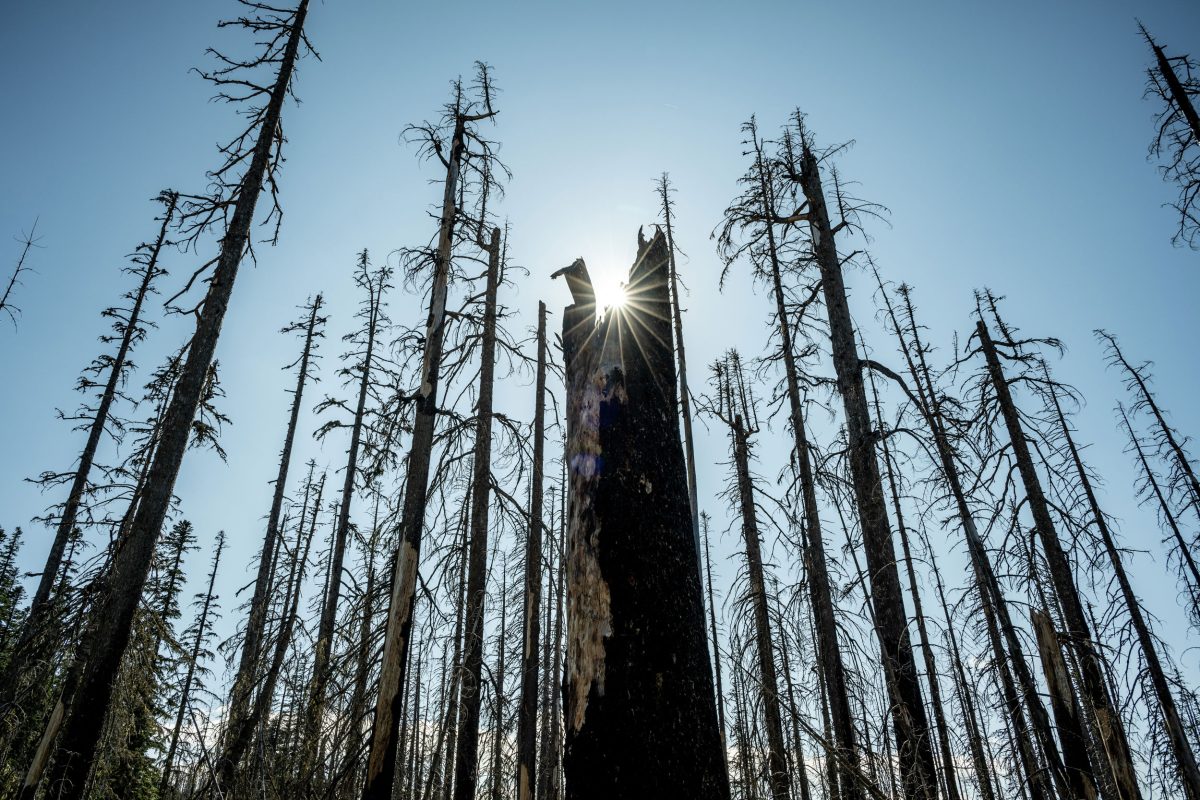
Managing wildfires on the wet west side of coastal mountains will likely need a different plan than the strategies government agencies use to fight inland wildfires. Photo by Stuart Isett
Karen Kopper, a fire ecologist for North Cascades National Park, northeast of Seattle, believes old-growth Pacific Northwest rainforests also have a higher chance of long-term survival and health than some other forest types—even as average temperatures rise. “Climate change is not expected to be as extreme in the Pacific Northwest,” she says. Kopper has been studying both recent and historical fires in the region—which raises what the US National Park Service calls a “gnarly issue”—a novel problem of fire management that past agency policies don’t provide much guidance on. She says fires on the wet west side of the Cascades have to be managed differently than on the arid rain-shadow side of the mountains in forests and rangeland that may receive less than 100 centimeters of annual precipitation.
For instance, in a drier forest, the intensity of a fire is constrained mainly by how much burnable material sits on the ground. Counterintuitively, aggressively fighting too many fires in such an ecosystem can make future wildfires worse, because frequent, moderate fires clear away some of the smaller trees and undergrowth that could power an even larger, more severe fire. That’s why prescribed fire—the strategy of deliberately setting a moderate fire—works so well in many forests. It’s also why many ecologists argue that some wildfires should be allowed to burn, and that overzealous firefighting can worsen the risk of an uncontrollable megafire. In a dry forest, a smaller good fire makes an extreme bad fire less likely.
But the same strategies may not work in a wet forest or rainforest—where fires are limited mainly by dampness. A wet forest is usually piled high with leaf litter, mosses, twigs, and understory plants. This material holds so much moisture that it actually keeps wildfires away. For much of the year, trying to light a flame here would be like taking a match to a bundle of damp laundry. But once a fire does burn in a wet forest, the remaining plant matter and debris is exposed to sunlight and wind and may become drier and more flammable. A fire in a rainforest may create conditions for the forest to carry repeated fires in years to come. Kopper argues that aggressive firefighting may be a useful strategy in parts of this damp region, especially for saving its remaining old growth. “If we can suppress the fires when they’re small and try to just wait out that long, dry summer period for the wet winters again,” she says, “then overall, we’re still supporting that same moist forest.”
When hit with dry conditions, a coastal rainforest has enormous amounts of fuel to power a fire. Video courtesy of the Washington Department of Natural Resources
And if the moist forest stays put, it is holding onto carbon. According to a study led by Beverly Law at Oregon State University, the Pacific Northwest possesses “some of the highest carbon density forests in the world, which can store carbon in trees for 800 years or more.” In this and a second study, Law and her colleagues concluded that commercial logging produces more carbon emissions than wildfires in Oregon, Washington, and California (though their data only ran through 2016). (Logging emissions can come from the fossil fuels burned by equipment and from the rapid rotting of disturbed soil and the noncommercially useful parts of dead trees, crowns, branches, understory trees, and other forest matter in addition to the conversion of carbon-rich trees into wood products, though the picture is nuanced. Many scientists and foresters have found that thinning, as opposed to clearcutting, can make some forests more resilient to drought, pests, and wildfire.) Law and other scientists have petitioned the Biden administration to create a US strategic carbon reserve—modeled after, but in most ways opposite from, the US Strategic Petroleum Reserve.
Other complications—such as insects, windstorms, avalanches, and landslides—can all take out trees. Still, “there’s massive potential for these forests to continue to soak up carbon from the atmosphere—if we allow them to continue to grow,” insists Michael Case, a scientist with The Nature Conservancy (the US counterpart to Canada’s Nature United).
That said, eventually, the recipe could also fail. “Under a high warming scenario, a longer summer dry period may lead to drought stress and decreased growth,” Case and his colleagues write in the article “Forests of the Future.” Add too much heat, and many forests cannot survive.
When Brian Harvey was young, he was afraid of forest fires. One of his first memories of watching television was in 1988, at age seven, when news broke that fire was tearing through Yellowstone National Park, blackening more than 300,000 hectares, about one-third of the park.
Harvey grew up in the San Francisco Bay Area, and his parents always took him camping and hiking in summers. “I remember just being sort of blown away by how magical forests could be,” he says. So the sensational reports of Yellowstone’s devastation that summer upset him. Scarier still was a firestorm in the Oakland hills on the east side of the Bay three years later, which burned about 3,000 homes and killed 25 people. “I remember just being really terrified of fires and forest fires as a kid and thinking of them—as many of us do—as this really scary and destructive force.”
Then in the 1990s, he made three trips to Yellowstone with his family and was stunned to witness how much of the park had recovered. He avidly read every interpretive sign. “I was like, Wow, this forest is really coming back pretty vigorously.”

Some researchers are studying how to regrow a forest with old-growth properties. Photo by Stuart Isett
By the time he became a professor at the University of Washington, about two decades later, he had devoted himself to studying forest fires. But forests rarely ignited on the coastal side of the state. Some famous coastal-side fires stand out in the region’s history—including the 1902 Yacolt Burn, which lit up nearly 100,000 hectares in southwest Washington. But until recently, studying fire in the Pacific Northwest was usually a history project. To know when the last burn happened in a rainforest here—often centuries ago—you might have to drill a pencil-sized core into the center of old trees and examine their rings or gather bits of pollen and charcoal from lake sediments. In some places, archaeological work and oral histories have turned up evidence of past fires ignited deliberately by Indigenous communities to create space for berries or other food plants. Lightning started many other fires.
In summer 2017, Harvey was driving across the mountains when the Norse Peak Fire closed the road. Though this fire was less than one-fifth the size, by area, of the state’s largest wildfire on record, the blaze was surprising for a different reason—it burned through wet forest. Harvey saw it as a learning opportunity.
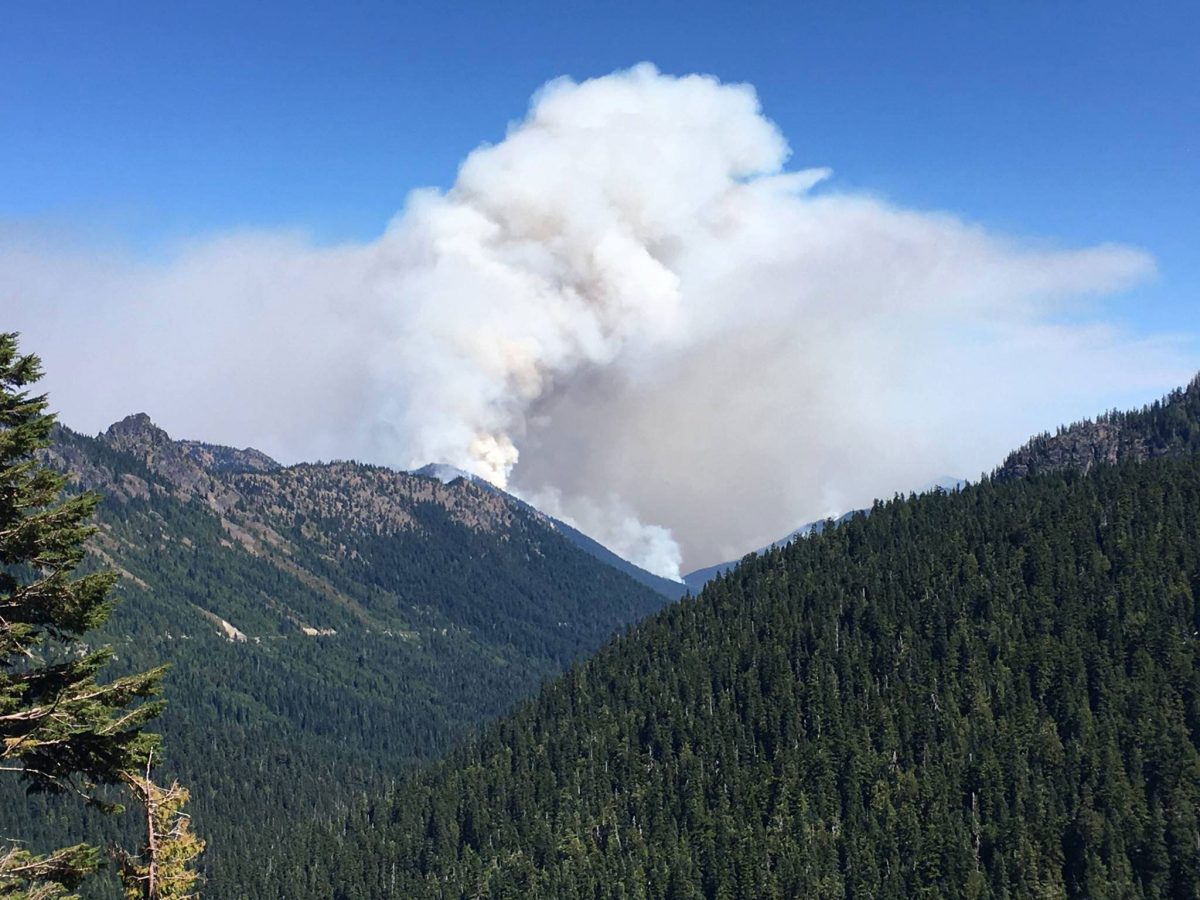
Wildfires are not entirely alien to coastal rainforests—they have happened in the past—but understanding them is becoming more urgent as the climate and environmental conditions change. Photo courtesy of the Washington Department of Natural Resources
His research has since attracted the attention of scientists throughout the region—and elsewhere in the world—who want to understand the fate of temperate rainforests in a warmer era.
After Harvey and the visiting scientists finish touring the patch of old-growth forest, the group loads back into the van and heads into the Norse Peak Fire scar. Dust froths up from the road as they emerge into an area covered with a stubble of bare gray-and-black stems. Mount Rainier appears stark and white on the gleaming horizon.
The scientists retrieve a set of orange hard hats from the back of the van before stepping into the forest. Here the trees are nearly all dead—and more likely to fall or drop branches onto the heads of visitors. Harvey doesn’t want the group to trample the undergrowth and distort his research, so he avoids taking them directly into his study plot. They walk just upslope through a formerly intact old-growth forest, now burned.
With no live tree cover, the air is hot, and the sun glares harshly. Harvey stacks a pair of chunky sunglasses over his regular glasses. At first, it’s hard to notice anything except how bare the ground is and how desolate the standing dead trees look—blackened and stripped of needles, their naked branches curled and fragile.
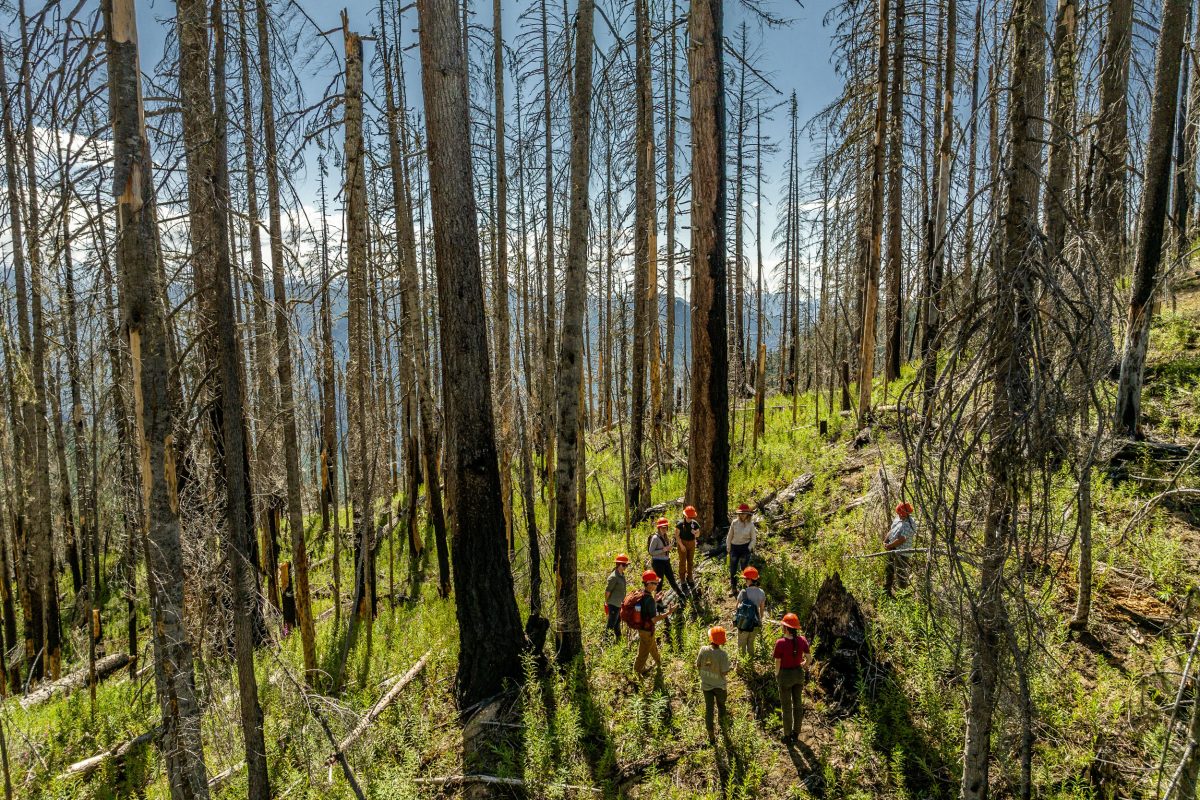
A mix of students and seasoned researchers take in the response of the old-growth forest to the Norse Peak Fire. Photo by Stuart Isett
But the forest floor is speckled with green, and Laughlin points out some of the same species that appeared at the previous site—such as pearly everlasting and fireweed, a pink-blossomed spiky plant named for its tendency to sprout after a burn. Harvey spots beargrass—not grass at all but a mountain flower that ranges along the West Coast (also used by Indigenous communities in California for making baskets and regalia, according to Royale Williams, an undergraduate researcher with Harvey’s lab who is Karuk and enrolled in the Quartz Valley Indian Reservation). Above them stands one partly alive old Douglas fir—whose bark was thick enough to offer it a modicum of protection—and a noble fir, which was probably just lucky. At shin height, a group of little seedlings cluster together. Laughlin crouches down and wags their stems affectionately—silver fir, noble fir, Douglas fir, hemlock.
It’s a surprising gathering of seedlings, she explains. Typically, botanists think of noble and Douglas firs as trees that prefer sunlight and exposure, and hemlock and silver fir as shade dwellers—sprouting after other trees and plants have given them some cover. But Laughlin, Harvey, and the rest of their research crew have found something unexpected in their old-growth plots post-fire. “Both of these players are establishing at the same time,” says Laughlin. The old-growth forests simply have more ingredients to start with, “more seeds on the menu,” explains Harvey.
In other words, even after a severe fire, an old-growth forest is better able to recover than an area that has been logged.

Laughlin notes the seedlings rising from a burned patch of old growth—silver fir, noble fir, Douglas fir, hemlock—not always seen together at this early stage in their lives. But even when burned, old-growth forests offer rich growing conditions. Photo by Stuart Isett
Moreover, as scorched as this place looks, even the deadwood that remains has a purpose. About 80 to 90 percent of the woody carbon is still here, Harvey says. “Like there’s downed logs that were on the forest floor that didn’t get consumed,” he points out. “There’s trees that were alive or dead at the time of the fire that are still standing.” Old-growth forests bank their carbon in various places.
All these factors make old-growth forests more resilient and more important than younger ones in the face of climate change.
Less than 30 percent of the old-growth forests of the Pacific Northwest in the United States are still standing. On the Canadian side, losses may be even greater. Less than 20 percent of British Columbia’s forests are old growth, according to the provincial government, but perhaps as little as one percent is highly productive old growth, according to a recent analysis by three independent researchers.
So when forest fires arrive in the Pacific Northwest, they are often burning through second growth, sometimes in an industrial landscape—a plantation that may be full of trees that are densely stocked, about the same age, and, on the US side of the border, belonging to a handful of species, especially the commercially valuable Douglas fir. Younger trees have thinner bark and are less likely to live through a burn than their elders. Sometimes, commercial foresters even use herbicides to prevent plants and shrubs from growing alongside the timber. This strategy is supposed to give trees unfettered access to nutrients, water, light, and space without competition from other plants, but in reality, it stops the formation of an understory that can protect the trees by gathering moisture on the forest floor. Some experts say that plantation forests managed this way are less resilient to fire and other risks.
“We kind of set up our landscape for vulnerability by a lot of clearcutting and conversion of primary forests to planted forests, weeding out the broadleaf species [those found in the rainforest’s understory], which are the most fire-resistant species. We are creating a more uniform landscape for fire to funnel through,” says forest ecologist Suzanne Simard at the University of British Columbia. (Simard is famous for proposing that trees may intelligently trade resources with one another through underground fungal networks, an idea that inspired the blockbuster movie Avatar and the bestselling novel The Overstory.) A focus of her work now is developing sustainable forestry practices that protect the workings of the forest ecosystem—including carbon storage.
Simard says conserving old-growth forests is one of the most important climate-protection steps British Columbia can take. “It’s taken thousands of years to build that forest floor, and we lose 60 percent [of the carbon] right away with logging,” she says. “It just is crazy to think that we’re actually still doing this in this time when we’ve got to be going to net-zero [carbon].”
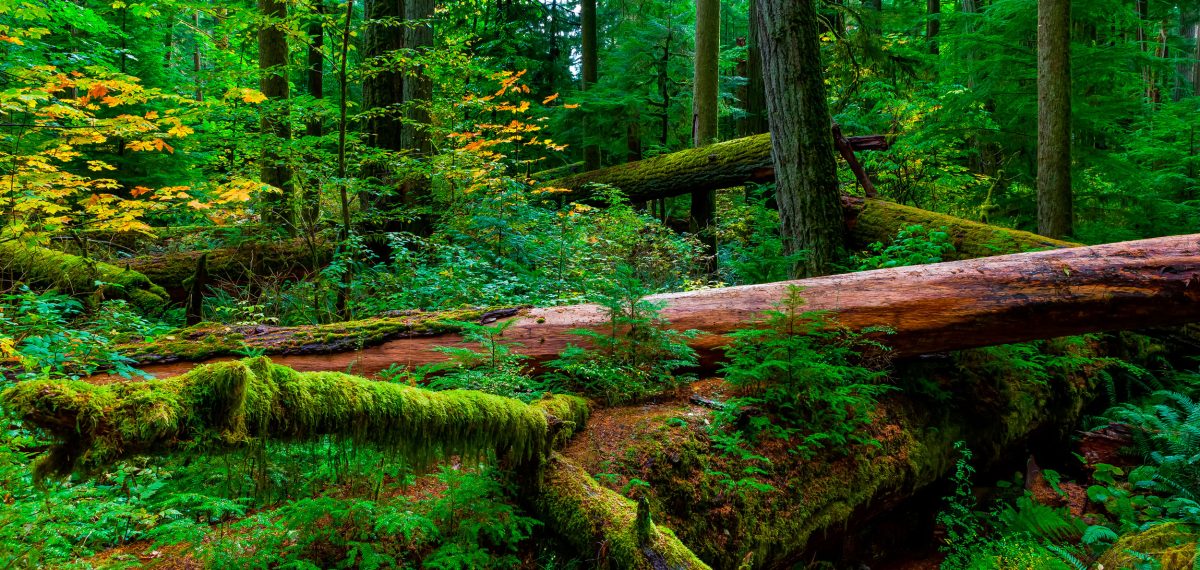
On Vancouver Island, Cathedral Grove offers a glimpse of the Pacific Northwest’s pre-logging past: green dampness and lush foliage. Photo by Design Pics Inc/Alamy Stock Photo
This also means that commercial foresters should be managing their trees more like old-growth forests.
Michael Case and some of his colleagues at The Nature Conservancy have been experimenting with a formerly logged swath of coastal forest in Washington to see what that might look like. In areas planted with a monoculture of Douglas fir, they are thinning back some of the trees and planting species like western red cedar (not favored by timber companies in Washington because it grows too slowly). Their restoration work has also allowed some understory plants to reestablish, like huckleberry and cascara, the latter a slender shrub whose leaves, flowers, and berries feed a multitude of birds, insects, and mammals. Over a period of about two decades, these restored forests have started to look more complex and multigenerational than before, more like old growth. Case hopes to show that it’s possible here to grow an old-growth-ish forest that’s also profitable. “The model that we’re trying to showcase here is one in which you don’t have to clearcut to make it viable. There can be an element of thinning, of having longer rotations,” he says.
At his forest plots, Brian Harvey tries not to read hope or doom or other foregone conclusions into the landscape. But what he has found so far has important implications for anyone in search of a forest-making recipe.
The final place he brings his scientists to on that sunny July day is formerly logged forest—completely burned over. They clamber down from the road into a patch of spindly black tree stems, their branches curled inward. The trees here were shorter, so the fire scorched them top to bottom—killing all. On the ground are fewer seedlings. “We’re seeing the lowest relative abundance of seedlings in these young-tree fire stands,” says Laughlin. There is also far less carbon here than in the burned old growth, probably because it began with less—no big, old trees.
It is not a lifeless place. Laughlin points to stems of willow and dwarf bramble (which looks like a petite raspberry) creeping along the ground. She and one of her colleagues also hover over one noble fir seedling and try to count nodes on the stem that would tell them how old it is. It looks like a four-year-old to Laughlin, which means it sprouted just a couple of years after the fire. But overall, it will be harder for this forest to grow back. It has fewer ingredients than its old-growth counterpart. Like other burned second growth, it may also be more vulnerable to reburning.
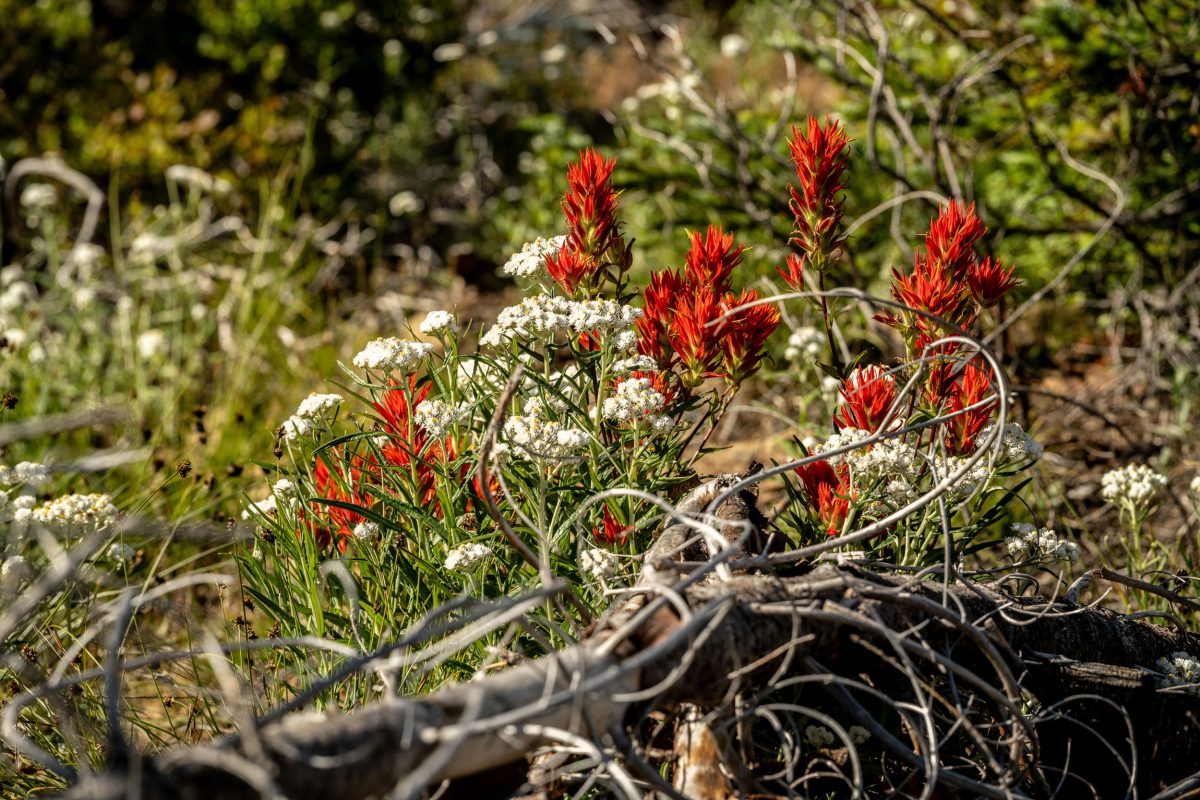
Brilliant crimson paintbrush and other plants sprout in sections of old-growth forest that were damaged by the 2017 Norse Peak Fire. Photo by Stuart Isett
Harvey’s research shows how vital old-growth rainforest remains to the Pacific Northwest in a time of heat and fire. Old growth is stronger, more resilient, a better keeper of carbon (even after fire), and better able to recover than the millions of hectares of forest that have been logged.
To study old-growth forests—with their slow regeneration—is also to engage with deep time. “The dynamics of these forests really unfold over multiple human lifetimes,” reflects Harvey. His 165 forest plots are like “the first leg of a relay race,” he says, and he will have to hand them off to an upcoming group of researchers to see what happens over decades.
This is both the trouble with and the beauty of forests, of course. Making and protecting a forest is the work of multiple generations.
